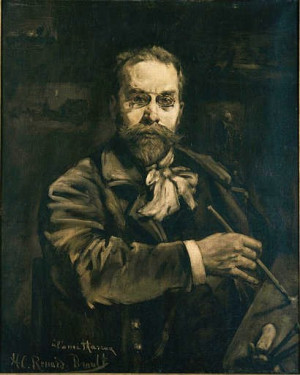Ernest-Victor Hareux ( - )

Ernest Victor Hareux was born in Paris on 10 May 1847. He trained as a painter from an early age and entered the École des Beaux-Arts in Paris, where he studied under masters such as Emile Bin, Léon Bonnat, Charles Busson and Léon Germain Pelouse, all leading figures in French academic painting. He made his debut at the Paris Salon in 1868, where he exhibited regularly throughout his career.
Specialising in landscape painting and genre scenes, Hareux was strongly influenced by the naturalism that was emerging at the time. He strove to depict nature in its most immediate truth, with great attention to light, atmosphere and the details of everyday rural life. He was also an excellent animal painter. His work was awarded the Prix Rose Bonheur in 1904.
In the 1880s, he moved to Grenoble, where he joined a circle of artists who later became known as the École dauphinoise. This group, following in the footsteps of the Barbizon school, focused on mountain landscapes, particularly those of the Dauphiné, with a realistic and sensitive approach. Hareux became an important figure in this movement, alongside Jean Achard, Théodore Ravanat and Charles Bertier.
He was also close to the École de Crozant, in Creuse, another major centre of French landscape painting, frequented by Armand Guillaumin and others. In both cases, he sought to capture the essence of places, between realistic rigour and the poetry of nature.
Hareux was recognised by his peers: he became a member of the Société des Artistes Français, received an honourable mention at the 1889 Salon and a third-class medal in 1891. He was also awarded the Légion d'honneur in 1906, crowning an esteemed career. He also wrote a treatise on painting, which was much appreciated by amateurs and contributed greatly to his reputation.
He died in Grenoble on 17 December 1909, leaving behind a rich body of work, consisting mainly of Alpine landscapes, rural scenes and portraits, painted in a masterful, sincere style. His works can now be seen in several French museums, including the Musée de Grenoble and the Musée de Pau.